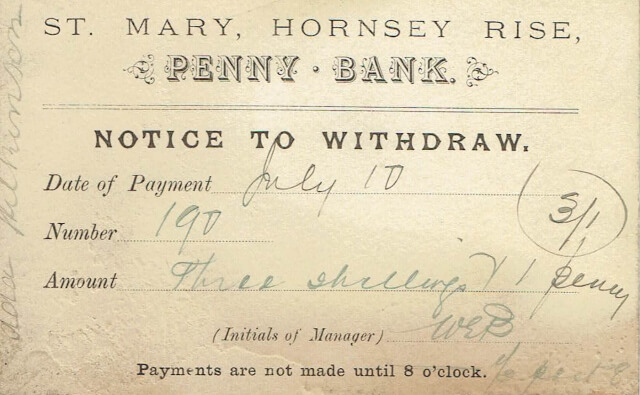The virtues of thrift and sobriety were highly prized in Victorian society. Mrs Priscilla Wakefield (1750-1826), born in Tottenham, philanthropist and a Quaker author of children’s books, founded a Penny Bank for children which was to develop into England’s first savings bank.
The movement took off in Scotland in 1848 and was rapidly followed by many others in Yorkshire and London. In his 1882 book, Thrift, Samuel Smiles said, ’The penny bank is emphatically the poor man’s purse’.
In 2006 a box was discovered in the loft of a house in Ashley Road off Crouch Hill and offered to the Hornsey Historical Society as being of possible interest. The box contained 190 payment record books relating to the penny bank established in St Mary’s Parish, Hornsey Rise. There was also a bag containing a few dozen withdrawal slips in various stages of disintegration. Thirty two of the 100 accounts examined had been opened at the earliest recorded date of the penny bank – January 1888. There must be more payment books somewhere as the highest book number seen was 651. No records were found later than December 1889 so the scheme probably fizzled out around that time. (The sterling figures quoted have today’s equivalent figure in square bracket – ed.).
The depositors are identified only by numbers and initials. In addition, six have ‘Mrs’ before their initials but there is no reference to single women. Two accounts never contained more than 2d.[£3] and these were emptied after two months. Mostly, the accounts held a few shillings. Depositor No.1 was evidently enthusiastic as his account contained the largest amount – £3 12s 7d [£1,500]. However, because of the pattern of deposits and withdrawals, he only ever earned 5d [£8] interest. Only seven others out of the hundred achieved savings amounting to more than one pound. The reverse side of the payment book, listing the bank rules, shows that interest was as hard to come by then as it is today. In fact, only four savers in total managed to get any interest at all, the highest amount being 1s 6d [£29].

Furthermore, withdrawals were not made easy. The requirement to give a week’s notice, leave the book for examination in the meantime, and return promptly at the required time on Tuesday evening to collect the money were quite onerous conditions. Despite this, another noticeable feature was that out of the hundred, thirty made withdrawals in December (in time for Christmas), and even those with reasonable funds were unable to leave them undisturbed until the following January when interest would be added.
Penny banks were frequently established in schools. The depositor books found in the loft state, ‘the object of this Bank is to foster provident habits amongst workpeople, children and servants in the Parish’. There is a report in the 19th January 1882 edition of the Hornsey Journal of a meeting in Hornsey National School rooms at which T Bowden Green, Hon. Sec. of the Hornsey Penny Bank, gave details of the bank’s transactions since it was set up in June 1881. This was followed by a lecture on, ’The Advantages of Thrift’ by Mr W E Church, who named William Cobbett and Benjamin Franklin as outstanding examples of this virtue.
Also, there are reports in the Hornsey Journal in February and September 1884 of meetings of the Hornsey School Board in which news of penny banks at the Board’s schools are recorded as a regular part of their business, along with finance and planned works. Clearly a concerted attempt was being made to inculcate good habits in the young.
St Mary’s Church, Hornsey Rise, was built in 1861 on land donated by Mr Thomas Warlters, who had lived in the area since 1791. It was a rapidly expanding parish in 1881 when Rev. W S Lewis was appointed vicar. HHS possesses a pamphlet on the history of the parish, written by Watson Surr, for many years one of the churchwardens. Surr relates how the Mission Hall was built in 1878 and describes how the vicar fostered various church social activities including the foundation of a Mutual Improvement Society.
The Mission Hall in Marlborough Road where all the business of the St Mary’s Parish Penny Bank was carried on still exists but no longer belongs to the church. It has been converted into two flats, one of which is currently (2011) for sale at an asking price of nearly half a million pounds.